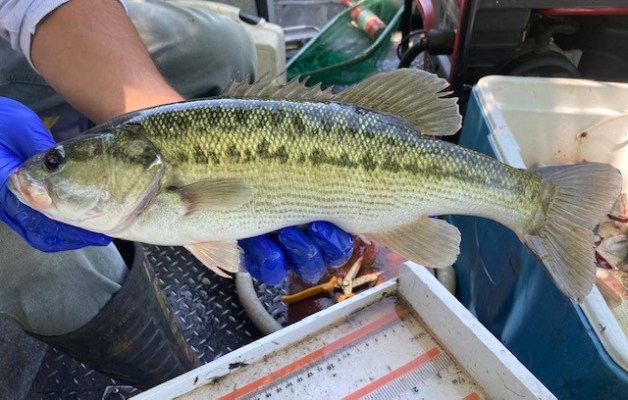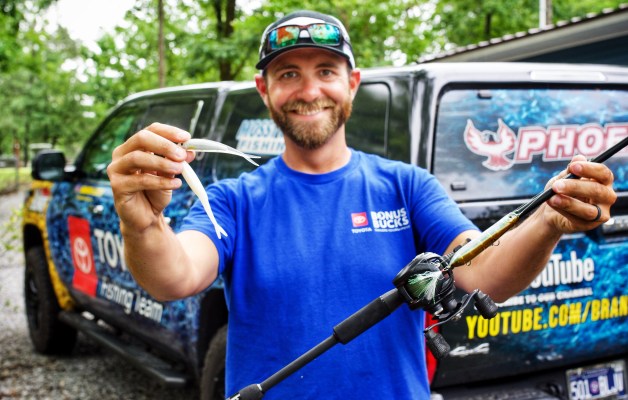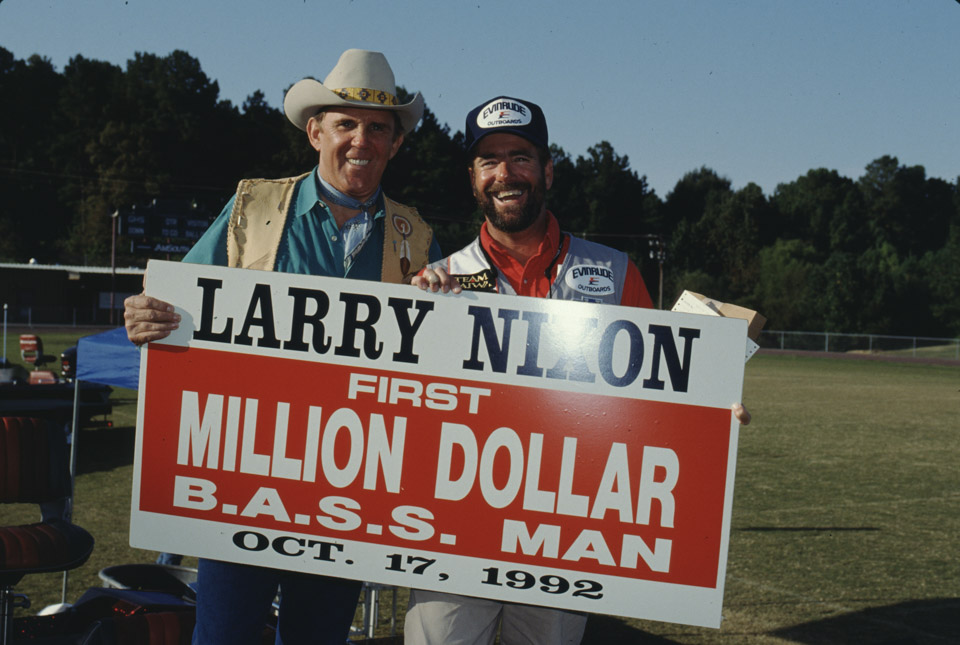
For most professional bass anglers, winning two Bassmaster Angler of the Year titles and a Bassmaster Classic trophy over the short span of three years is more than adequate to define their entire career.
Such was on the resume of Larry Nixon, who won AOY in 1980 and 1982, followed by the 1983 Classic. Yet with all those accolades, there would be another even more amazing feat that would truly define Nixon’s career over the course of the 1980s into the next decade.
In 1986, B.A.S.S. introduced the first-of-its-kind, made-for-TV tournament called B.A.S.S. MegaBucks. The Top 10 anglers after a four-day qualifying round would advance to a two-day final’s competition, rotating through a 10-hole course. Each angler fished 50 minutes in each hole, then rotated to the next, until fishing through all the holes. The small size of the course allowed video cameras to capture the drama as it unfolded during the day. The special aired on TNN: The Nashville Network as part of The Bassmasters TV series.
What else intentionally set MegaBucks apart, and hence its name, was the $2,000 entry fee with a $600,000 payout, unheard of then, and years ahead of its time. The winner would earn $100,000.
The first MegaBucks was held on the Harris Chain of Lakes, with the 10-hole finals course ideally located in Little Lake Harris, a 2,743-acre dish bowl-shaped extension of the larger Lake Harris.
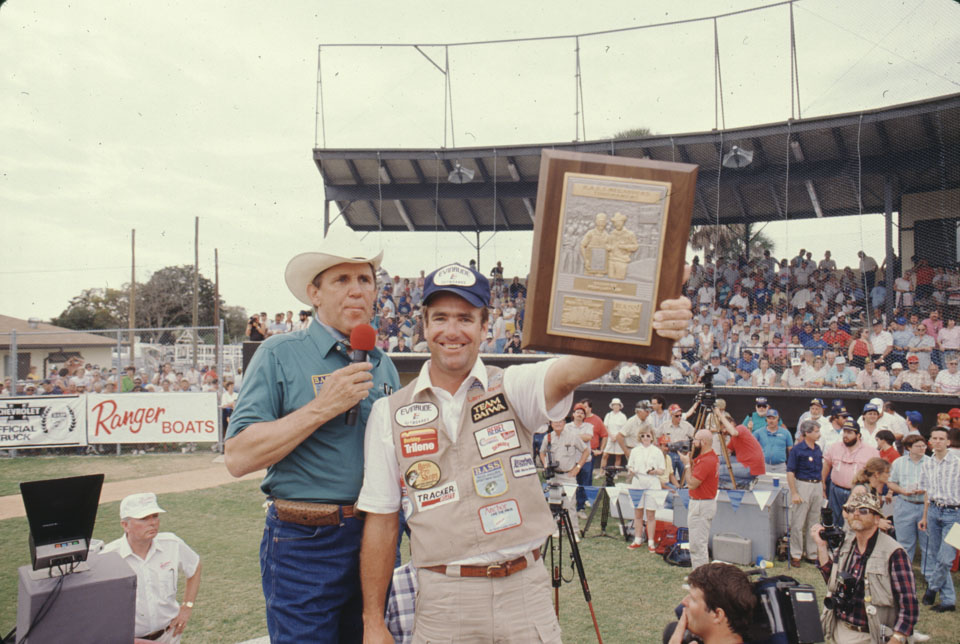
Nixon didn’t fish the first MegaBucks, he missed the cut in 1987, and then began a run of MegaBucks dominance that earned him the nickname “Mr. MegaBucks.” Between 1988 and 1991, Nixon won Megabucks an astounding four times. Those wins came in 1988 and 1990 at the Harris Chain, and later that year at Lake Guntersville. His fourth win came in 1991 at Chickamauga Lake.
Although Nixon didn’t win in 1992 (Denny Brauer did), his fourth-place finish at Guntersville pushed his B.A.S.S. winnings over $1 million. As a result, Nixon became the first professional bass angler to become a millionaire based on earnings alone. Not bad for a one-time Toledo Bend guide, originally from Bee Branch, Ark.
The million-dollar milestone was memorable, but there was another Nixon memory that put the exclamation point on the idea behind the made-for-TV, capture-the-winning-moment MegaBucks plan.
That stellar moment occurred as Nixon’s 1988 win played out on Little Lake Harris at Hole #6. As if cued by the rolling video camera, Nixon connected with a largemouth weighing 10 pounds. As the trophy bass made an acrobatic leap, Nixon turned to the camera and provided the perfect sound bite — “Oh my gosh, look at the size of that bass” — as the fish made yet another leap, this one closer to the nearby camera boat. The catch would end up in the show opening as a fan favorite.
MegaBucks was a grueling endurance test held over six days of competition, beginning with the three qualifying days when the full field of up to 200 anglers competed in a boat draw-style format. The field was cut to the Top 50 on Day 4, with those anglers vying for the Top 10 spots for the two-day finals. Weights were zeroed for the championship round, when the finalists competed solo. Starting positions were determined by a draw, adding even more challenges to the finals, as some holes were thought to be sweeter than others. during specific times of the day.
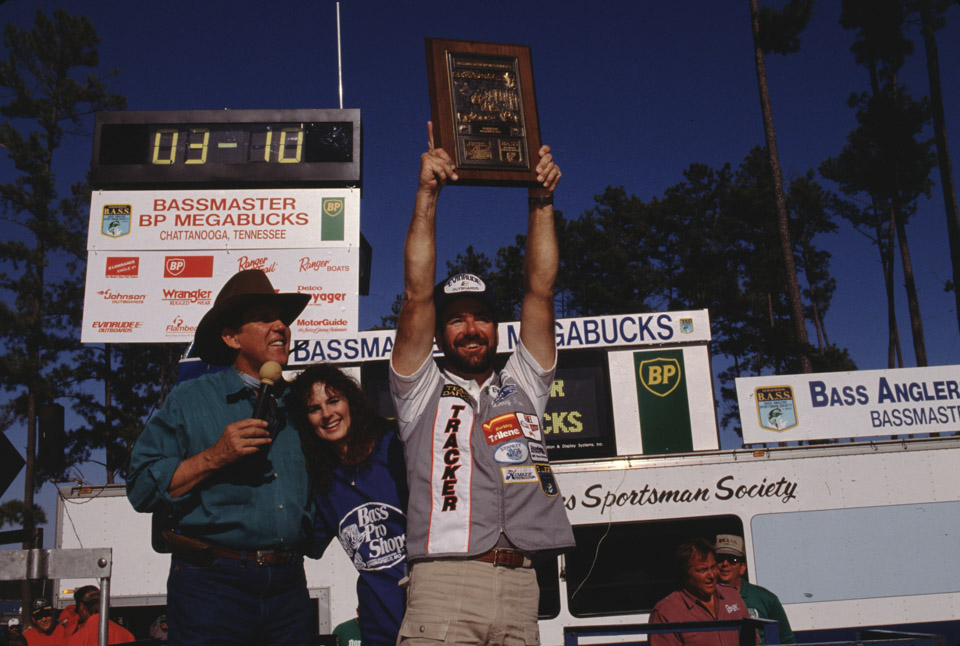
That begs the question: What made Nixon so good at winning MegaBucks?
There are multiple answers, beginning with he was, and is, just plain good. The “is” part meaning Nixon will resume his B.A.S.S. career in 2023 on the Bassmaster Elite Series. On the first go-around, he cashed checks in 177 of 261 events, fished 25 Classics (winning in 1983), had 14 wins, a dozen second-place finishes and the two AOY titles.
Fundamentally, what could be another reason were Nixon’s humble beginnings as a Toledo Bend guide, starting in the mid-1970s. Spending some 300-plus days on the water, and on the line to earn his keep for a day’s worth of guiding a client, certainly added to his skills.
Perhaps Tommy Martin, another B.A.S.S. legend and also originally a Toledo Bend guide, put it best.
“If we could only have one day of fishing for every tournament, Nixon would win them all,” Martin once said. “He’s the best angler in the world at figuring out quickly how to catch fish.”
Ideally, how Nixon would approach MegaBucks was simple. He would target the most obvious — and highest percentage spot first — catching a bass and then expanding from there as the clock ticked away for each hole.
“You had a full eight-hour day to get it done,” Nixon recalled. “But you had to treat each hole individually, like a mini tournament within the tournament.”
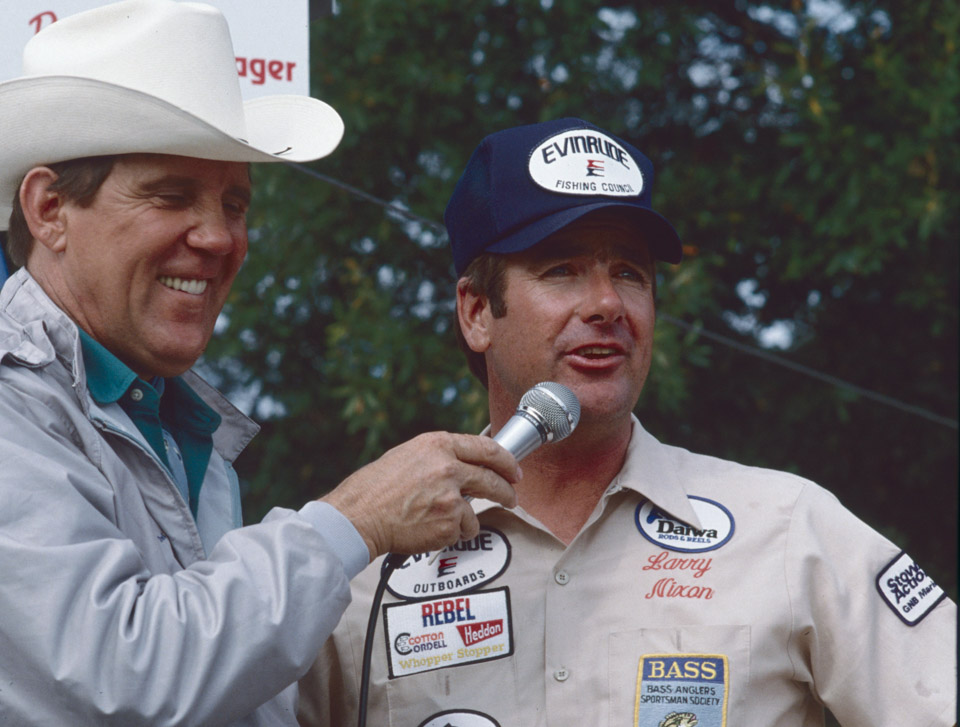
The MegaBucks backstory
Sometime in 1985 I was visiting B.A.S.S. headquarters in Montgomery, Ala., and then-tournament director Harold Sharp waved me into his office. He handed me a yellow legal pad with a pencil-drawn sketch of a lake, divided into 10 sections. And thus began the dream behind MegaBucks. Ray Scott, Bob Cobb and Sharp thought big, and even then, he envisioned eventually holding the tournament on a lake where spectators could watch it from the shoreline, just as they would a PGA tournament.
Fast forward to 1987. Sharp retired, promoted to his position was Dewey Kendrick, and I became assistant tournament director, working in that role at the next four MegaBucks tournaments until I transferred to the editorial department. Kendrick took MegaBucks to the next level, and I was blessed to be part of it.
It’s not in the article, but the MegaBucks winner didn’t receive the $100,000 cash up front. Instead, he received a $20,000 check, and then an $8,000 annuity payment for the next 10 years. Unplanned, of course, but that benefited Nixon by providing a longterm tax break, while providing a guaranteed source of income over time.
Back then, our B.A.S.S. Invitational tournaments lasted three days, doubling the time for MegaBucks, logistically treating it like two events in one. Setting up the 10-hole course began at the office with Dewey marking the boundaries of the course on a topographic lake map. At the lake, we’d then eyeball the most ideal spots along the shorelines to hammer the hole boundary signs into the bottom, going from one to the next around the lake. Buoys were set across the lake to compete the course.
We had to prepare for MegaBucks differently than other tournaments. Scorecards were used to record catch-by-catch details, just like keeping tally of strokes on a golf scorecard, in keeping with the original idea. We had a drive-through weigh. We designed special maps for the course, among many other details. Logistically, it was like a mini-Classic.
During the finals I served as the course rules official and official timekeeper. That required keeping watch on the clock, and then sounding an air horn to signal time to rotate to the next hole at the 50-minute intervals. If any rules issues came up, it was me who was there to act if needed. Fortunately it never happened.
That job came with perks. I had a boat to myself and got to stand down between hole changes. I witnessed Nixon’s famous catch, watching all of his reactions and banter with Bob Cobb and the camera guys after the fish went into the livewell.
At the Harris Chain, always a treat was returning together as a flotilla of 10 boats to the drive-through weigh-in at the lakeshore ballpark in downtown Leesburg, Fla. The stands were filled with 2,500 spectators, with the scales mounted on a platform inside a Ranger Boat serving as the stage.
And yes, it was always memorable to see Nixon hold up the winner’s plaque. All four times.




